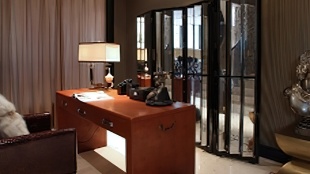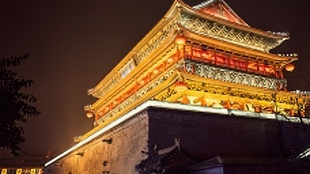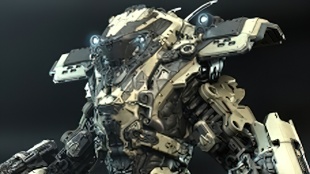您需要 登录 才可以下载或查看,没有账号?注册

x

Introduction
My name is Jamey Brand. I am 23 years old and I'm currently a third-year game art student studying at Breda University of Applied Sciences in the Netherlands.
介绍
我的名字是Jamey Brand。我今年23岁,目前是荷兰布雷达应用科学大学(Breda University of Applied Sciences)的三年级游戏艺术学生。
Before I started studying at BUAS I studied graphic design at Grafisch Lyceum Rotterdam. In my first year at GLR, I got introduced to Unity as we had to make a small city using pre-made assets. I loved using a real-time engine so in my second year I chose to specialize in 3D art. While the subjects we were taught at GLR regarding 3D art were basic, it was a good way for me to get introduced to the subject and learn about software like 3ds Max and Cinema 4D.
在我开始在BUAS学习之前,我在鹿特丹Grafisch Lyceum学习平面设计。在 GLR 的第一年,我被介绍给 Unity,因为我们必须使用预制资源来制作一个小城市。我喜欢使用实时引擎,所以在第二年,我选择专攻3D艺术。虽然我们在GLR学到的关于3D艺术的科目是基本的,但这对我来说是介绍该科目并学习3ds Max和Cinema 4D等软件的好方法。
In my third and final year at GLR, I had to do an internship and was lucky to be accepted as a prop-art intern at Vertigo Games. During my time at Vertigo Games, I produced props for the Arizona Sunshine DLCs and their recently released VR game After the Fall.
在GLR的第三年也是最后一年,我不得不做一个实习,很幸运地被Vertigo Games录取为道具艺术实习生。在眩晕游戏公司工作期间,我为亚利桑那州阳光DLC和他们最近发布的VR游戏After the Fall制作了道具。
While I was pretty efficient at creating quality game-ready prop assets, I wanted to further improve my skills as an Environment Artist and started my journey at BUAS.
虽然我在创建高质量的游戏就绪道具资产方面非常高效,但我想进一步提高我作为环境美术师的技能,并在BUAS开始了我的旅程。

Getting Started
At the start of my second year at BUAS, we were tasked to create a building using modular elements, from either Vienna, Hanoi, or Havana in the span of 7 weeks. Havana took my interest because I found the decaying architecture really beautiful and unique.
开始
在BUAS的第二年开始时,我们的任务是在7周内使用维也纳,河内或哈瓦那的模块化元素创建一座建筑。哈瓦那引起了我的兴趣,因为我发现腐朽的建筑非常美丽和独特。
Once I decided to stick to the location of Havana, I started doing research online. I noticed that Havana does not have Google Street View which made it harder to find references. Because of this, I bought a picture reference pack on Artstation which contained loads of detailed pictures with buildings from Havana.
一旦我决定坚持哈瓦那的位置,我就开始在网上做研究。我注意到哈瓦那没有谷歌街景,这使得找到参考资料变得更加困难。正因为如此,我在Artstation上购买了一个图片参考包,其中包含大量来自哈瓦那的建筑物的详细图片。
I slightly altered the brief we were given by not replicating one building, but taking multiple parts of different buildings and combining them. The reason for this was mainly that I wanted to challenge myself and create something that had a more personal touch.
我稍微修改了一下我们给出的简报,不是复制一座建筑,而是将不同建筑的多个部分合并起来。这样做的原因主要是我想挑战自己,创造一些更个人化的东西。
Creating Individual Modular Pieces
I started with creating a block out of the building using simple shapes inside of Maya.
创建单独的模块化部件
我首先使用 Maya 内部的简单形状在建筑物外创建一个块。
I had recently acquired a VR headset when I was working on this project and I wanted to check out the model in VR. This was a great way at the start to observe the building and see how the scaling of everything was lining up. Besides, it gave me a good reason to try out Gravity Sketch.
我最近在做这个项目时买了一个VR头显,我想看看VR中的模型。这是一个很好的方式,在开始时观察建筑物,看看所有东西的缩放是如何排列的。此外,它给了我一个很好的理由来尝试重力素描。
Once I was satisfied with the rough look of the building, I started planning and creating each specific asset piece by piece.
Because of the limited time we had for the project, I decided to keep the models fairly simple and made it my main goal to have everything at a consistent detail level across the whole building.
Once I finished an asset I made sure to set the pivot on the correct location before bringing it over to Unreal Engine where I could start combining all the elements.
一旦我对建筑物的粗略外观感到满意,我就开始逐个规划和创建每个特定的资产。
由于我们用于该项目的时间有限,我决定保持模型相当简单,并将整个建筑物中的所有内容都保持在一致的细节级别作为我的主要目标。
完成一个资源后,我确保将枢轴设置在正确的位置,然后再将其带到虚幻引擎,在那里我可以开始组合所有元素。
For the cables that go across the building, I created a blueprint I learned from this tutorial.
对于穿过建筑物的电缆,我创建了从本教程中学到的蓝图。
Foliage
This was the first time I had to create foliage for a project, it was great because it allowed me to learn a variety of different techniques instead of having to just focus on the building. Because I had no prior experience creating foliage, it was an interesting challenge for me and gave me the ability to leave the building for a bit and solely focus on creating the ivy.
For the creation of the ivy, I started sculpting a set of four different ivy leaves in ZBrush. Once I was done sculpting, I reduced the polycount, imported them into Maya and started placing them on top of a plane for the high poly bake.
树叶
这是我第一次不得不为一个项目创建树叶,这很棒,因为它让我能够学习各种不同的技术,而不必只关注建筑。因为我之前没有创造树叶的经验,所以这对我来说是一个有趣的挑战,让我有能力离开建筑物一段时间,只专注于创造常春藤。
为了创造常春藤,我开始在ZBrush中雕刻一套四种不同的常春藤叶子。完成雕刻后,我减少了多边形计数,将它们导入Maya,并开始将它们放置在平面顶部以进行高多边形烘焙。
Once I had the layout ready, I took it into Substance 3D Painter and baked the high poly leaves on the plane. Inside SP, I changed the shader to “pbr-metal-rough-with-alpha-blending’’ in the shader settings so that I was able to see the alpha cut out of the ivy leaves in the viewport.
To get the Alpha mask for the leaves, I used the Thickness map that I had just baked.
一旦我准备好布局,我就把它带入Substance 3D Painter,并在飞机上烘烤高聚叶。在 SP 内部,我在着色器设置中将着色器更改为“pbr-metal-rough-with-alpha-blending”,以便能够在视口中看到常春藤叶子的 alpha 切口。
为了获得叶子的阿尔法蒙版,我使用了我刚刚烘焙的厚度贴图。
From this folder, I exported the Thickness map and inverted it in Photoshop, imported the inverted texture back into SP, and now used it in my opacity channel as the masking texture for the ivy.
The texturing for the ivy was done using different Smart Masks, adding noise textures, and using the maps I had baked in the beginning, for example, using the baked Curvature map to get the highlights on the veins of the leaves.
从这个文件夹中,我导出了厚度贴图并在Photoshop中将其反转,将倒置纹理导入SP,现在在我的不透明度通道中将其用作常春藤的遮罩纹理。
常春藤的纹理是使用不同的智能蒙版完成的,添加了噪点纹理,并使用我在开始时烘焙的地图,例如,使用烘焙的曲率贴图来获得叶子脉络上的高光。
Because I had only baked the leaves on the plane and hadn't included the roots of the plant, I added them in Photoshop by manually drawing them in. While this looks fine from a distance, up close it starts to look too stylized. For future ivy creation, I will definitely include these roots in the bake and create them in either ZBrush or Maya.
因为我只在飞机上烤了叶子,没有包括植物的根,所以我通过手动绘制它们将它们添加到Photoshop中。虽然从远处看这看起来很好,但近距离看,它看起来太风格化了。对于未来的常春藤创作,我肯定会将这些根包含在烘焙中,并在ZBrush或Maya中创建它们。
Texturing of the Building
For the color palette, I wanted to capture the same visual style I had found in my reference, which was these desaturated colors you see on the decayed buildings from Havana.
建筑物的纹理
对于调色板,我想捕捉我在参考资料中发现的相同视觉风格,即你在哈瓦那腐朽的建筑物上看到的这些不饱和的颜色。
Texturing of the building was done using Substance 3D Painter. Inside SP, I made use of the Smart Masks/dirt generator tools to quickly achieve the aged/dirty look. I always start with a base color and then add layers on top of that. Because the assets were not intended to be seen from very up close, I kept this process fairly quick not worrying too much about the small details.
建筑物的纹理化是使用Substance 3D Painter完成的。在SP内部,我利用智能面具/污垢发生器工具快速实现老化/肮脏的外观。我总是从基色开始,然后在基色上添加图层。由于这些资产不是为了近距离观察,所以我保持这个过程相当快,而不是太担心小细节。
When I had all the assets in the engine and the building was assembled, I started adding decals I made myself in Photoshop on top of it to break up the repetitiveness and add that extra layer of detail and smudginess. The decals worked great because the smaller details of the textures would get lost from a distance.
当我在引擎中拥有所有资源并且建筑物组装完毕时,我开始在它上面添加我自己在Photoshop中制作的贴花,以打破重复性并添加额外的细节和污迹。贴花效果很好,因为纹理的较小细节会从远处丢失。
Lighting and Rendering
Even though the project was finished before the deadline given by my university last year, I was not satisfied with the lighting I had done and wanted to take more time to rework it before posting it on my portfolio. Roughly one year later I decided it was time to fully finish the project. This time I opened it in Unreal Engine 5 to try out the new Lumen setting. While I did not do a whole lot of research on how to use Lumen, I immediately noticed the softer and more realistic look this gave to the scene.
光照和渲染
尽管这个项目在去年我的大学给出的截止日期之前完成了,但我对我所做的照明并不满意,并希望花更多的时间重新设计它,然后再将其发布到我的投资组合中。大约一年后,我决定是时候完全完成这个项目了。这次我在虚幻引擎5中打开了它,尝试了新的Lumen设置。虽然我没有对如何使用Lumen进行大量研究,但我立即注意到这给场景带来了更柔和,更逼真的外观。
During the original start of this project, I lost quite some time halfway through because I was constantly tweaking the lighting and trying out different lighting scenarios. In the end, I decided to go with both a warm daylight scene and a night scenario with some subtle storytelling included (the orange glow coming through the window, implying someone is staying in this building).
在这个项目最初开始时,我中途浪费了相当多的时间,因为我不断调整照明并尝试不同的照明场景。最后,我决定同时选择温暖的日光场景和夜间场景,包括一些微妙的故事讲述(橙色的光芒穿过窗户,暗示有人住在这栋楼里)。
For the lighting, I used 2 directional lights in both the day and night scenes as the main light sources. One of them cast a strong light on the left of the building and the other a softer filler light on the right side. I also used some spotlights to create subtle rim lighting on the ivy to make them pop more.
对于照明,我在白天和黑夜场景中都使用了2个定向灯作为主要光源。其中一个在建筑物的左侧投射强烈的光线,另一个在右侧投射出较柔和的填充光。我还使用了一些聚光灯在常春藤上创造微妙的边缘照明,使它们更加流行。
In terms of post-processing, I made some small changes to the color grading, slightly tweaking the saturation, contrast, and gamma.
在后期处理方面,我对颜色分级进行了一些小的更改,稍微调整了饱和度,对比度和伽玛。
I also enabled bloom and played with the threshold to give that little bit of glowing effect, mainly prominent on the ivy.
我还启用了绽放,并玩弄了阈值,以产生一点点发光效果,主要在常春藤上突出。
Challenges
My main challenges were that at one point during the creation of this project I got dissatisfied with where things were heading. During this time, I decided to focus on the creation of foliage and leave the building behind for a bit. I noticed the change of work made me regain motivation and drive for the project.
挑战
我的主要挑战是,在创建这个项目的过程中,我一度对事情的发展方向感到不满。在这段时间里,我决定专注于树叶的创造,并暂时离开建筑物。我注意到工作的变化使我重新获得了项目的动力和动力。
Also in the early stages of the project, I lost quite some time because I was slightly changing small aspects of the building, for example, changing up the way the balcony looked like or later deciding to tweak the damaged parts on top.
同样在项目的早期阶段,我浪费了相当多的时间,因为我稍微改变了建筑物的小方面,例如,改变了阳台的外观,或者后来决定调整顶部的损坏部件。
As for tips for beginners wanting to create a modular building, I would say pick something from clear reference and try not to make it too complicated (like how I wanted to combine different parts of different buildings together) so that all your focus can go towards the modeling, texturing and lighting for the project.
至于想要创建模块化建筑的初学者的提示,我会说从清晰的参考中选择一些东西,并尽量不要让它变得太复杂(比如我想如何将不同建筑的不同部分组合在一起),这样你所有的注意力就可以放在项目的建模,纹理和照明上。
|







 评分
评分







